Lekce 1: Piston Pumps
Kapitola 1: Piston Pumps
Piston pumps are a type of water pumps which cause the liquid to flow using one or more oscillating pistons.
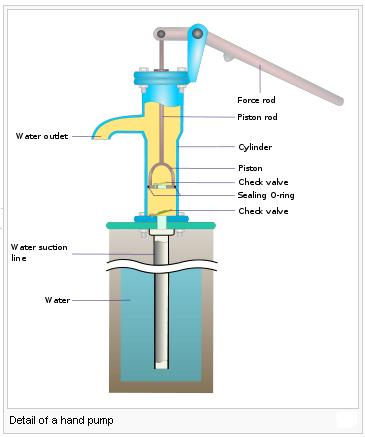
Piston pumps belong among the reciprocating pumps. They need a system of suction and dischargevalves, thanks to which the fluid is moved in a required direction. There are various types – some of them have just one cylinder (called simplex-cylinder pump), others may have up to four cylinders (quad-cylinder pump) or even more. Most reciprocating pumps are duplex- or "triplex-cylinder types (with two or three cylinders).
Types according to the way of suction and discharge
Piston pumps can also differ according to the direction of suction and discharge.Single acting piston pumps have independent suction and discharge strokes, while double acting pumps perform suction and discharge in both directions.
Application
Piston pumps are usually driven by air or steam, or by a belt drive from an independent engine. Piston pumps were very popular in the times of the industrial revolution in the 19th century, but nowadays they are used less often. Their usual application is for pumping fluids with high resistance, where high flow rate is not needed. Typical pumped materials include for example concrete and heavy oils.
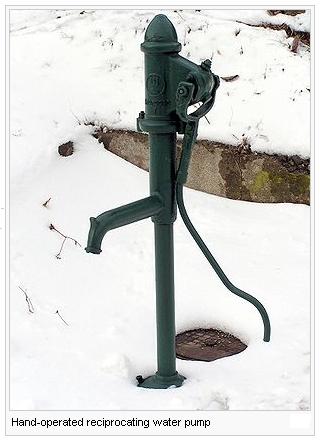
Vocabulary
Piston pump – pístové čerpadlo
Piston – píst
Liquid – kapalina
Flow – téct
Cylinder – válec
Suction valve – sací ventil
Discharge valve – výtlačný ventil
Fluid – tekutina
Independent – nezávislý
Stroke – doba, zdvih pístu
Perform – provádět
Driven – poháněný
Steam – pára
Belt drive – pásový pohon
Industrial revolution – průmyslová revoluce
Application – použití
Resistance – odpor
Flow rate – rychlost toku, průtoková rychlost
Concrete – beton
Oil – olej
Obrázky a fotografie použité v této kapitole pochází ze stránek {Wikimedia Commons XH http://commons.wikimedia.org}, kde byly zveřejněny pod licencí {GNU FDL XH http://commons.wikimedia.org/wiki/Commons:GNU_Free_Documentation_License}.
Kapitola 2: Cvičení
- Studenti zpracují na téma Piston Pumps powerpointovou prezentaci.
Kapitola 3: Kontrolní otázky
- Can you briefly describe piston pumps?
- In what ways can they be divided?
- What are some typical materials, which are pumped by piston pumps?
Kapitola 4: Autotest
- How many pistons do piston pumps have?
- How many cylinders does a quad-cylinder pump have?
- Which type of pumps have independent suction and discharge strokes?
- Which type of pumps perform suction and discharge strokes in both directions?
- Piston pumps are used
Lekce 2: Piston Compressors
Kapitola 1: Piston Compressors
Description
Piston compressors (often also called reciprocating compressors) are a type of positive-displacement compressors, driven by a crankshaft. They convey gases at high pressure. The intake gas flows through the suction manifold into the compression cylinder. Here a piston, which is driven by a crankshaft, compresses the gas, which is then discharged.
Application
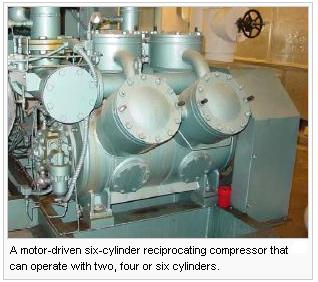
Reciprocating compressors are used in many kinds of industries. We can find them in gas pipelines and natural gas processing plants, oil refineries, chemical factories and refrigeration plants. Plastic bottles made of polyethylene terephthalate (PET) are also manufactured by blowing with the use of piston compressors.
Piston compressors can be made as a portable tool, which can power various machines. In the past they were used to drive for example pneumatic drills. Such a unit was usually mounted on a trailer and the compressor was driven through a centrifugal clutch by an engine, usually diesel. The engine had a speed limiter (or a governor), which enabled it to run at two speeds:
- idling, the clutch was disengaged
- maximum, the clutch was engaged and the compressor was running
Vocabulary
piston compressor, reciprocating compressor – pístový kompresor
positive-displacement compressor – objemový kompresor
driven – poháněný
crankshaft – kliková hřídel
convey – dopravit
pressure – tlak
intake gas – nasávaný plyn
suction manifold – sběrné sací potrubí
compression cylinder – vzduchový válec
piston – píst
compress – stlačit
discharge – vytlačit
application – využití
industry – průmysl
gas pipeline – plynovod
natural gas processing plant – továrna na zpracování zemního plynu, plynárna
oil refinery – ropná rafinérie
refrigeration plant – chladící zařízení
polyethylene terephthalate – polyethylentereftalát
blowing – vyfukování
portable – přenosný
tool – nástroj
power – pohánět
pneumatic drill – pneumatická sbíječka
unit – stroj, agregát
mounted – upevněný, namontovaný
trailer – přívěs
centrifugal clutch – odstředivá spojka
diesel engine – naftový motor
speed limiter, governor – omezovač otáček, omezovač rychlosti
idling – volnoběh
engaged clutch – zapnutá spojka
disengaged clutch – vypnutá spojka
rotary compressor – rotační kompresor, kompresor s otočnými písty
Obrázky a fotografie použité v této kapitole pochází ze stránek {Wikimedia Commons XH http://commons.wikimedia.org}, kde byly zveřejněny pod licencí {GNU FDL XH http://commons.wikimedia.org/wiki/Commons:GNU_Free_Documentation_License}.
Kapitola 2: Cvičení
- Studenti zpracují na téma Piston Compressors powerpointovou prezentaci.
Kapitola 3: Kontrolní otázky
- Can you describe piston compressors?
- Can you give some examples, where they are used?
- Why are portable piston compressors not used very much nowadays?
Kapitola 4: Autotest
- What is the difference between piston compressors and reciprocating compressors?
- Where is the gas compressed?
- How are the pistons usually driven?
- What is a portable compressor?
- Why are portable piston compressors not used very much nowadays?
Lekce 3: Spark-ignition Engines
Kapitola 1: Spark-ignition Engines
Spark-ignition engines are a type of internal combustion engines. Unlike the compression-ignition engines, where the heat resulting from compression ignites the fuel mixture, in spark-ignition engines it is ignited with an electrically produced spark.
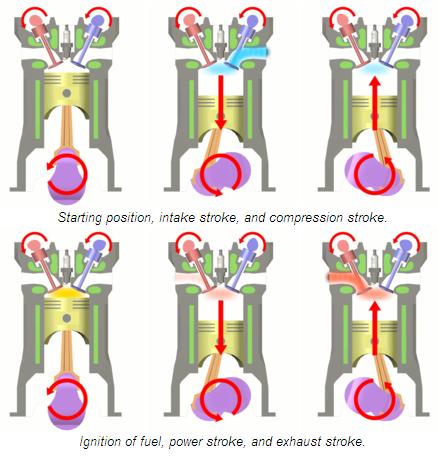
Division
There are two types of spark-ignition engines:
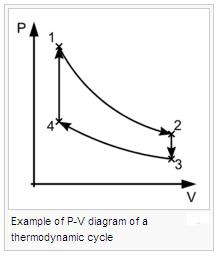
Fuel mixture
Because the fuel mixture typically consists of air and petrol (gasoline or gas in American English), they are usually referred to as petrol engines (gasoline engines or gas engines in American English). However, other fuels can be used as well, such as autogas (LPG), compressed natural gas (CNG), methanol, ethanol or hydrogen. Cars in drag racing usually use nitromethane.
Mixing process
Spark-ignition engines were traditionally distinguished from compression-ignition engines also according to the place, where the fuel is mixed with air. While the compression-ignition engines blend fuel inside the cylinders, in spark-ignition engines it was done outside the cylinders, in a carburettor. However, in modern engines highly pressurized fuel is injected directly into the cylinders, which improves the efficiency of the engines. This process is called gasoline direct injection (GDi).
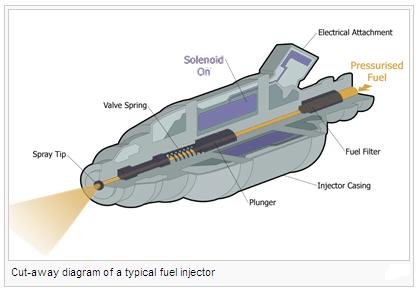
Vocabulary
spark-ignition engine – zážehový motor
internal combustion engine – motor s vnitřním spalováním
compression-ignition engine – vznětový motor
heat – teplo
compression – stlačení
ignite – zažehnout
fuel – palivo
fuel mixture – palivová směs
spark – jiskra
two-stroke engine – dvoudobý motor
four-stroke engine, Otto cycle engine – čtyřdobý motor
Wankel engine – Wankelův motor
piston – píst
simultaneously – současně
petrol (American English: gasoline, gas) – benzín
petrol engine (American English: gasoline engine, gas engine) – benzínový motor
blend – smíchat
cylinder – válec
carburettor (American English: carburetor) – karburátor
pressurized – pod tlakem
inject – vstřikovat
efficiency – výkon
direct injection – přímé vstřikování
autogas, LPG (Liquefied petroleum gas) – zkapalněný ropný plyn
natural gas – zemní plyn
hydrogen – vodík
drag racing – závody dragsterů
cat-away – průřez
Obrázky a fotografie použité v této kapitole pochází ze stránek {Wikimedia Commons XH http://commons.wikimedia.org}, kde byly zveřejněny pod licencí {GNU FDL XH http://commons.wikimedia.org/wiki/Commons:GNU_Free_Documentation_License}.
Kapitola 2: Cvičení
- Studenti zpracují na téma Spark-ignition Engines powerpointovou prezentaci.
Kapitola 3: Kontrolní otázky
- Can you briefly describe spark ignition engines?
- How can they be divided?
- Can you describe the P-V diagram?
Kapitola 4: Autotest
- Spark-ignition engines are a type of
- In which type of spark-ignition engines do the strokes take place simultaneously?
- What does a typical fuel mixture for spark ignition engines consist of?
- Which of the following is more typical for modern spark ignition engines?
- What does CNG mean?
Lekce 4: Compression-ignition Engines
Kapitola 1: Compression-ignition Engines
Compression-ignition engine is a type of an internal combustion engine. Because it converts heat into work, it belongs among heat engines. Unlike spark-ignition engines, the fuel mixture is ignited by the heat resulting form the compression of the mixture. The fuel is injected into the combustion chamber in the final stage of the compression.
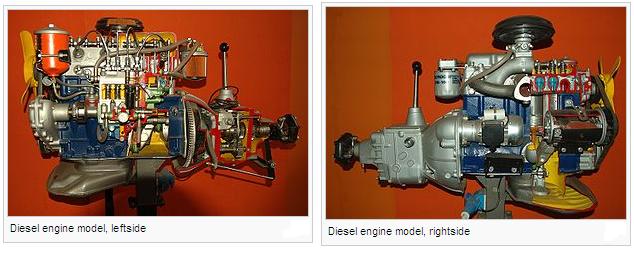
Operation
Compression-ignition engines are often also called Diesel engines, after the European inventor and mechanical engineer Rudolf Christian Karl Diesel. It operates using the so called Diesel cycle. The picture on the right shows a p-v diagram for the Diesel cycle, which follows four distinct processes.
- 1 to 2: compression (blue)
- 2 to 3: constant pressure heating (red)
- 3 to 4: expansion (yellow)
- 4 to 1: constant volume cooling (green)
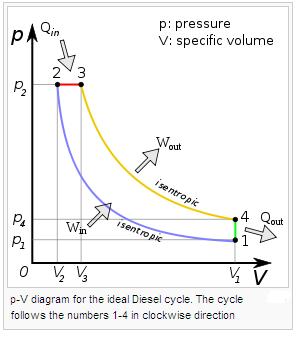
Types
Vocabulary
compression-ignition engine, Diesel engine – vznětový motor
spark-ignition engine – zážehový motor
internal combustion engine – motor s vnitřním spalováním
convert – přeměnit
heat – teplo
heat engine – tepelný stroj
fuel mixture – palivová směs
ignite – zažehnout
compression – stlačení
inject - vstříknout
combustion chamber – spalovací komora
combustion cycle – spalovací takt
four-stroke – čtyřdobý
two-stroke – dvoudobý
motor vehicle – motorové vozidlo
locomotive – lokomotiva
power-to-weight ratio – poměr výkonu k hmotnosti
fuel consumption – spotřeba paliva
clockwise – proti směru hodinových ručiček
Obrázky a fotografie použité v této kapitole pochází ze stránek {Wikimedia Commons XH http://commons.wikimedia.org}, kde byly zveřejněny pod licencí {GNU FDL XH http://commons.wikimedia.org/wiki/Commons:GNU_Free_Documentation_License}.
Kapitola 2: Cvičení
- Studenti zpracují na téma Compression-ignition Engines powerpointovou prezentaci.
Kapitola 3: Kontrolní otázky
- Can you briefly describe compression-ignition engines?
- How can they be divided?
- What are the processes of the diesel cycle?
Kapitola 4: Autotest
- Compression-ignition engines are a type of
- How is the fuel ignited?
- When is the fuel injected into the combustion chamber?
- What are the types of compression-ignition engines?
- Why do compression-ignition engines belong among heat engines.